

Special Tool - Top Plug Wrench (45 mm): 57001-1741
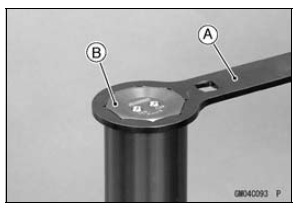
Special Tool - Top Plug Wrench (45 mm): 57001-1741
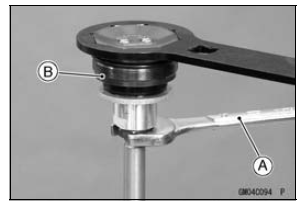
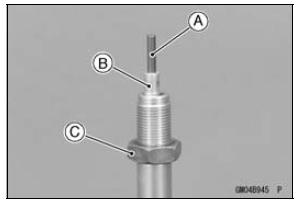
Special Tool - Rod Guide Case Wrench, 35 mm: 57001 -1758
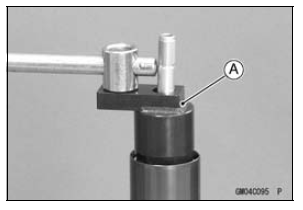
NOTICE
A socket of piston rod guide case is shallow (4 mm) and therefore be sure to check that the wrench (Special Tool: 57001-1758) is securely seated on the piston rod guide case.
When loosening the piston rod guide case. If the wrench is not securely seated on it, the piston rod guide case may brake.
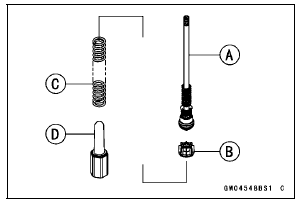
Pump the inner tube up and down at least ten times to expel the oil from the fork.
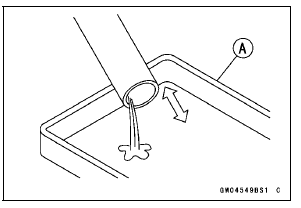
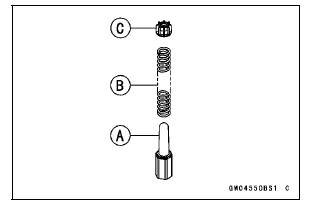
Pour the fork oil until the upper of the inner tube hole [A].
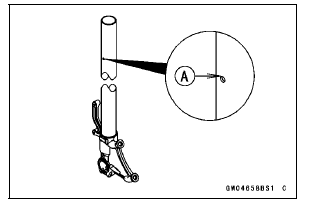
Fork Oil Recommended Oil: SHOWA SS-19: 44091-0009 Amount (Per Side): When changing oil: Approx. 420 mL (14.2 US oz.) After disassembly and completely dry (Total): 495 ±2.5 mL (16.7 ±0.085 US oz.)
NOTE
Lifting the outer tube, and insert the piston rod assy.
NOTICE
When inserting, be careful not to damage the piston ring [A].
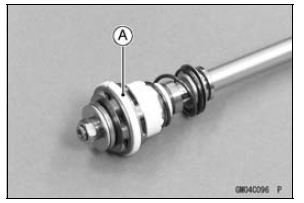
Special Tool - Rod Guide Case Wrench, 35 mm: 57001 -1758
Torque - Piston Rod Guide Case: 90 N·m(9.2 kgf·m, 66 ft·lb)
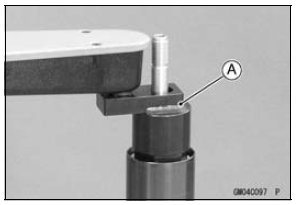
NOTE
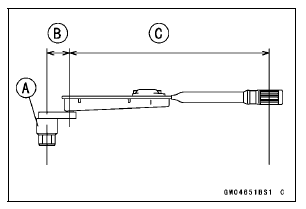
Formula: a × b ÷ (b + c) = d
[a] Specified torque
[b] Length from center of square hole to grip point
[c] Offset = 30 mm
[d] Tightening torque
For an example: 90 N·m × 450 ÷ (450 + 30) = 84 N·m
NOTICE
A socket of piston rod guide case is shallow (4 mm) and therefore be sure to check that the wrench (Special Tool: 57001-1758) is securely seated on the piston rod guide case.
When tightening the piston rod guide case. If the wrench is not securely seated on it, the piston rod guide case may brake.
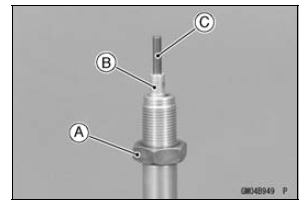
Special Tool - Top Plug Wrench (45 mm): 57001-1741
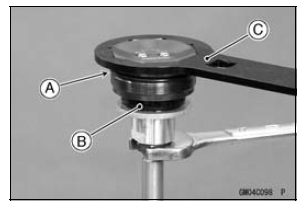
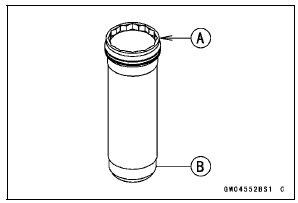
Hold the inner tube vertically in a vise.
Wait until the oil level settles.
With the fork fully compressed, insert a tape measure or rod into the piston rod guide case [A], and measure the distance [B] from the top [C] of the outer tube [D] to the oil.
Fork Oil Level (fully compressed) Standard: 85 ±2 mm (3.35 ±0.08 in.)
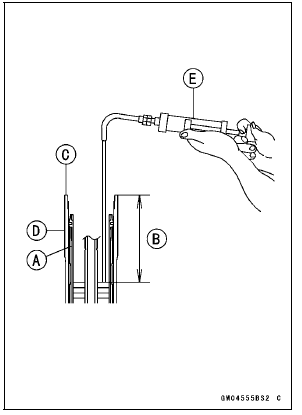
NOTE
Special Tool - Fork Oil Level Gauge: 57001-1290
Pull the handle slowly to pump out the excess oil until the oil no longer comes out.
If no oil is pumped out, there is insufficient oil in the inner tube. Pour in enough oil, then pump out the excess oil as shown above.
Special Tool - Top Plug Wrench (45 mm): 57001-1741
NOTE
After installing the front fork, adjust the spring preload and damping force correctly.
 Front Fork Installation (Each Fork Leg)
Front Fork Installation (Each Fork Leg) Front Fork Disassembly
Front Fork DisassemblySpecial Tools and Sealant
Compression Gauge, 20 kgf/cm²:
57001-221
Valve Spring Compressor Assembly:
57001-241
Valve Spring Compressor Adapter,
25:
57001-1019
Valve Seat Cutter, 45° - 27.5:
57001-1114
Valve Seat Cutter, 45° - 32:
57001-1115
Valve Seat Cutter, 32° - 28:
57001-1119
Valve Seat Cutter ...
Radiator and Radiator Fan Installation
If the radiator bracket [A] was removed, install it.
Install the radiator fan to the radiator
Tighten the radiator fan mounting bolts.
When installing the pad [B], install it so that the upper end
of the pad aligns with the corner top [C].
When install the pad [D], install it so that the ...
Stopping the Motorcycle in an Emergency
Your Kawasaki Motorcycle has been
designed and manufactured to provide
you optimum safety and convenience.
However, in order to fully benefit
from Kawasaki’s safety engineering
and craftsmanship, it is essential that
you, the owner and operator, properly
maintain your motorcycle and becom ...